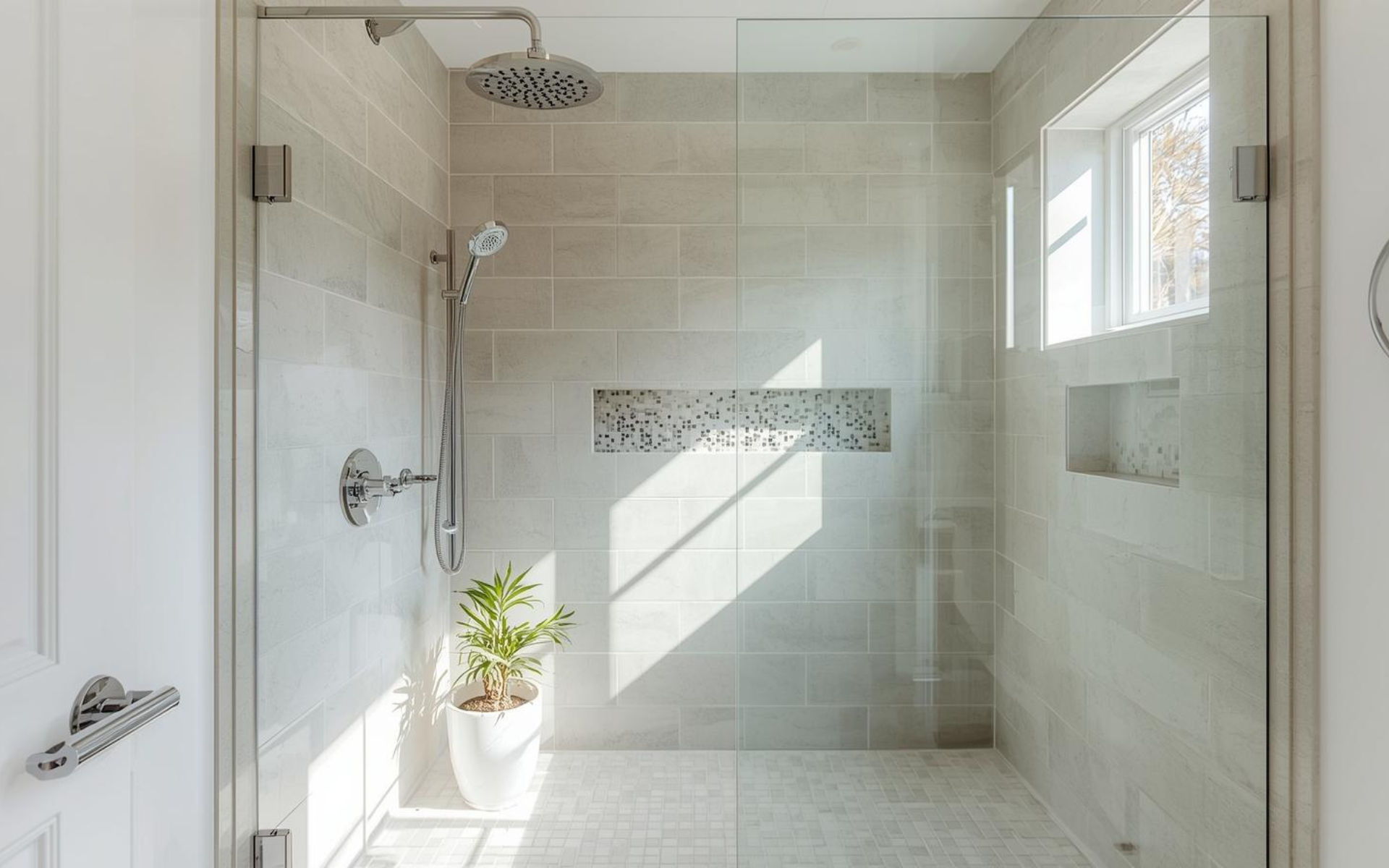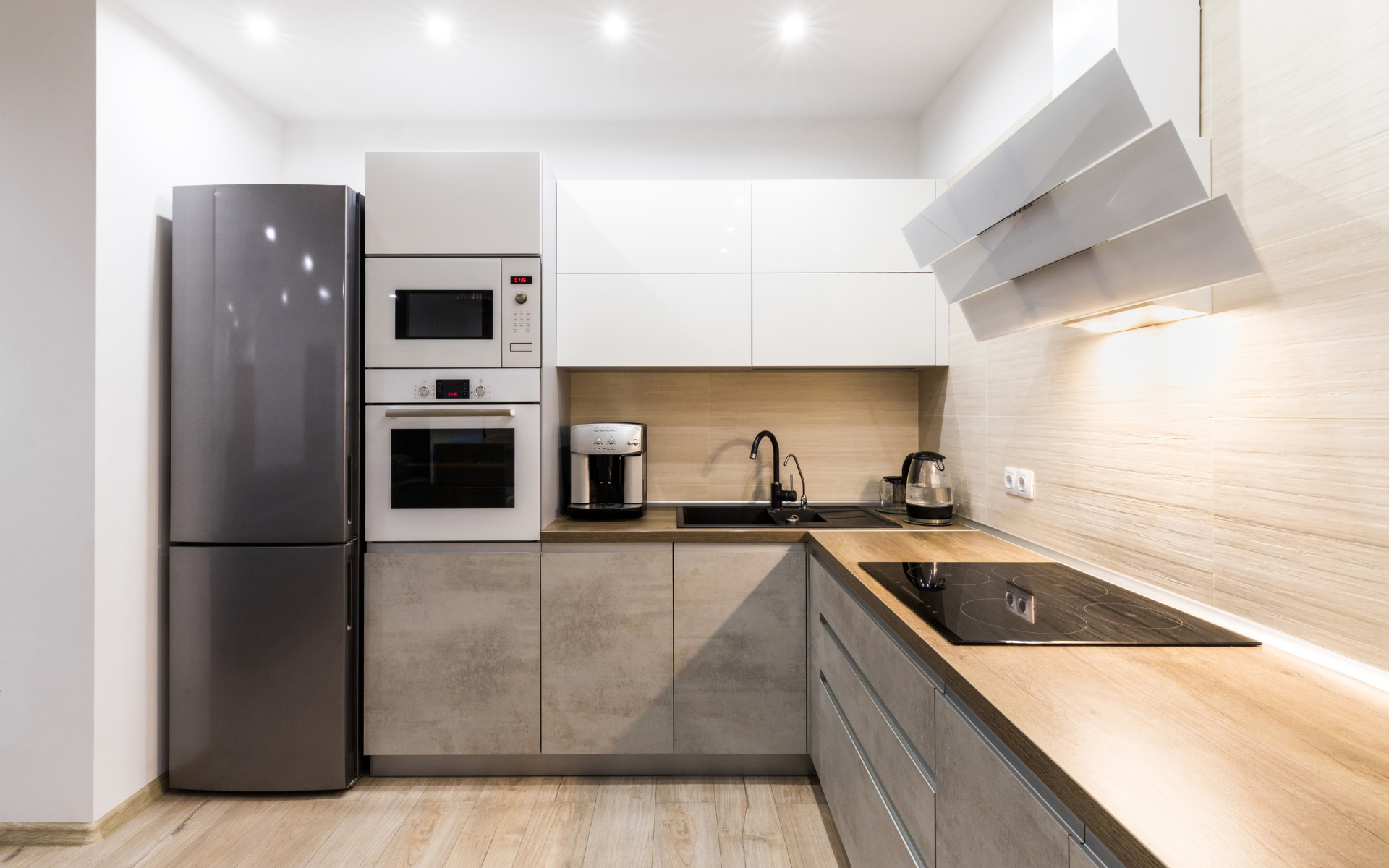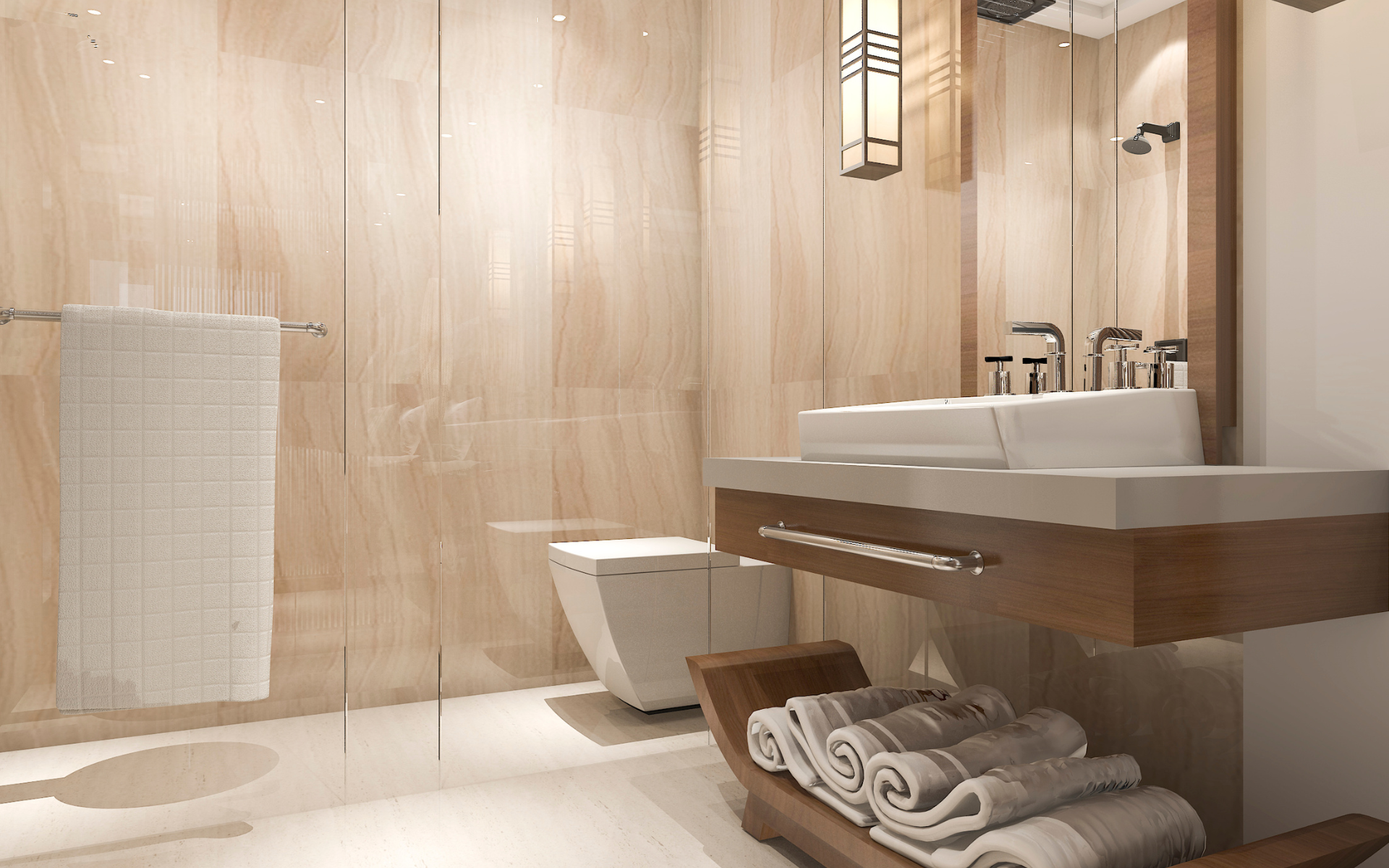Updating your shower can completely transform the way your bathroom feels and functions, but it all starts with a realistic shower remodeling budget. Knowing what to expect before you begin helps you plan wisely and avoid those mid-project surprises that can stretch your timeline or finances. Every decision affects the total cost, so it’s worth understanding where your money goes and how to make the most of it.
A well-planned bathroom remodeling project goes beyond new tiles and faucets. It’s about creating a space that fits your lifestyle, your routines, and your sense of comfort. In this post, we’ll walk through everything from national averages to cost-saving moves, so homeowners can build a realistic plan. We’ll lean on data from Angi and other up-to-date sources.
Table of Contents

What Is the Average Shower Remodeling Cost in 2025?
To start, let’s anchor expectations in real numbers. According to Angi, in 2025, the average cost to remodel a shower is about USD 7,000, though many projects fall somewhere between $2,000 and $9,000 depending on size, finishes, and complexity.
That wide range depends on the size of your space, the materials you choose, and how much work needs to be done. Your shower remodeling budget might be lower if you are simply replacing fixtures and tile, or higher if you are designing a custom walk-in shower with luxury finishes.
Here are a few comparable figures to help you calibrate:
A walk-in shower installation averages around $8,000 (though extremes range lower or higher)
For a walk-in style, some sources cite typical costs between $4,200 and $8,500 depending on features and finishes
Converting a bathtub to a shower might cost from $2,400 to $8,800, depending on layout and plumbing changes
So when people talk about “average cost of renovating a shower,” that $7,000 number is a useful reference point. But be ready to customize it to your home.
Let’s break down what influences your shower remodeling budget so you can estimate more precisely.
Key Factors That Drive Your Shower Remodel Budget
When you’re budgeting for a shower remodel, these are the major levers that cause your final price to swing up or down:
Shower Size & Layout
A small “shower stall” (32″ × 32″ or similar) will cost far less to tile, waterproof, and finish than a generous walk-in space. Every extra square foot adds material and labor.
Also, layout changes (moving walls, adjusting plumbing runs) can raise costs significantly. If your new design requires shifting drains, rerouting pipes, or altering structural elements, that’s extra money.

Material & Finish Quality
Materials often eat up 40-60% (or more) of your budget. Choices here make or break your cost:
Tiles: Ceramic, porcelain, mosaic, and stone each come with its price.
Waterproofing & substrate: Backer boards, membranes, sealants. Don’t skip quality here.
Shower bases/pans: Prefab vs custom-tiled pans differ greatly in cost.
Glass doors/enclosures: Framed, semi-frameless, frameless, sliding, pivot, barn style. These all have cost tiers.
Fixtures & hardware: Showerheads, valves, niches, benches, lighting, trim.
Accessories: Shelves, grab bars, shampoo recesses.
If you select higher-end or custom materials, you should expect your cost of shower remodeling to skew toward the upper end of the range.
Labor Rates
One of the biggest cost variables is labor. If your region has high contractor rates or a scarcity of skilled installers, labor will eat more of the budget. Also, tricky installations (uneven walls, odd dimensions, angled ceilings) cost more in labor time.
Demolition & Prep Work
Removing old tile, waterproofing layers, and old fixtures. This is time-intensive. Water damage, mold, or structural issues hidden behind walls can surprise you and add expense. Angi notes that demoing a bathroom typically costs $8-$20 per square foot, depending on complexity and what’s being removed.
Plumbing, Electrical & Structural Modifications
If you must relocate drains, adjust water lines, or rework electrical wiring (e.g., lighting, exhaust fans, steam unit), these are “extras” beyond tiling and finishes. Also, if walls or joists need repair or reinforcement, that needs to be in your buffer.
Permits & Inspections
In many jurisdictions, changing plumbing or altering walls requires permits or inspections. That adds both time and direct cost (permit fees or contractor markup). Always check local rules.
Contingency & Overruns
Every well-planned remodel needs a contingency. Things like hidden damage, change orders, or material delays. A safe cushion is usually 10% to 20% above your initial estimate.
How to Create Your Own Shower Remodeling Budget
Creating a realistic budget for your shower remodel project takes more than just adding up prices from a few online sources. It requires careful thought about your existing layout, your goals, and the overall design you want to achieve.
Here’s a rough process you can follow to arrive at a realistic shower remodeling budget (or compare contractor quotes). Let’s go through each part of the process step by step.
1. Assess Your Current Space and Define Your Vision
Start by taking a good look at your existing shower. Notice what works and what feels outdated. Does the layout still serve your needs, or are you ready for something more open, like a large walk-in shower? If your dream bathroom includes multiple shower heads, frameless glass doors, or heated flooring, keep those details in mind while setting your budget.
If your bathroom layout is functional, keeping your existing plumbing fixtures can save money. But if your goal is a full transformation, including plumbing upgrades or structural changes, expect additional costs. Knowing what to keep and what to replace is the first big step in creating a realistic budget.
2. Choose the Right Shower Type
Your shower type determines much of your total cost. A simple shower stall replacement is more budget-friendly than a custom tile enclosure. Prefabricated shower kits are great for DIY projects because they come ready to install and help lower shower costs. However, if you prefer a custom shower with detailed tile work, expect a higher price tag because of the labor involved.
Here are a few common options:
Prefabricated Shower Kit: Fast to install, ideal for a tight budget or DIY shower remodeling.
Custom Tile Shower: Allows creativity with patterns, natural stone, or porcelain tile but requires skilled labor.
Walk In Shower Remodel: Creates a spa-like experience with frameless glass doors and modern fixtures but may come with a hefty price tag.
Tub-to-Shower Conversion: Replacing an old tub with a shower can be cost-effective, though plumbing changes may add to your overall cost.
Your decision here shapes both the look of your dream shower and the financial direction of your remodel project.

3. Explore Shower Wall Options and Materials
Your shower wall material has a major impact on both design and cost. Each choice comes with different maintenance needs, visual styles, and installation requirements. If you want to save money, mix materials. For example, you might use porcelain tile for the main walls and a decorative band of stone for an accent. Balancing premium materials with practical ones keeps your shower remodeling budget under control without sacrificing aesthetic appeal.
4. Select Your Enclosure and Door Style
The shower enclosure defines the overall feel of the bathroom. You can choose from framed glass doors, semi-frameless designs, frameless glass doors, or even a simple shower curtain.
Framed Glass Doors: The most affordable and practical option for families or guest bathrooms.
Semi-Frameless or Frameless Doors: These add a sleek, modern look that enhances light flow and makes small spaces appear larger.
Shower Curtain: Still the simplest and most flexible choice, especially for a DIY project or temporary upgrade.
If you are upgrading from framed to frameless doors, remember that the hardware and glass thickness will affect your total project cost. Frameless options offer greater aesthetic appeal but can raise the price range considerably.
5. Decide on Fixtures, Features, and Upgrades
Fixtures often define the comfort and luxury level of your remodel. Your selections can range from basic shower heads to full spa systems with body jets and digital controls.
Think about what will make your dream shower truly enjoyable.
Modern Fixtures: Add functionality and water efficiency.
Multiple Shower Heads: Create a spa-like experience in a large walk in shower.
Handheld Sprays and Rainfall Heads: Enhance comfort and versatility.
Built-In Niches or Benches: Improve storage and convenience.
Heated Flooring: Adds comfort, especially in colder climates.
Luxury upgrades come with additional expenses, so balance your must-have features with what fits your realistic budget.
6. Understand Labor and Professional Costs
Even if you are tackling a DIY shower remodeling project, you may still need help from a professional contractor for plumbing or electrical work. Labor often accounts for a large portion of the total project cost, especially for custom showers that involve complex tile layouts or high-end materials.
Hiring an experienced contractor ensures a successful remodel because they can identify potential cost implications before construction begins. Skilled labor is not cheap, but poor workmanship can lead to expensive repairs later. Always compare prices and check reviews to find a trustworthy team.
7. Include Additional Costs
Your final price tag will always include some unexpected costs. Plumbing upgrades, damaged subfloors, or hidden leaks can add to your total. Plan for these by including a 10 to 20 percent contingency in your budget.
Other additional costs to keep in mind include:
Permit fees or inspection costs
Waste disposal or material delivery charges
Design consultations or custom fabrication fees
Lighting upgrades or ventilation improvements
8. Compare Prices and Balance Value with Savings
Before finalizing your plan, gather estimates from several contractors or suppliers. Comparing quotes gives you insight into price ranges for materials and labor.
You might find that one company offers better pricing on tile, while another specializes in glass enclosures. A bit of research helps you identify where to save money without cutting corners.
If you are on a tight budget, consider completing the remodel in stages. You can start with new shower walls or fixtures this year, then add luxury upgrades later. A phased approach allows flexibility while keeping your project affordable.
9. Review the Total Project Cost and Refine Your Plan
Once you have gathered all estimates, review your total cost carefully. Break it down into categories such as materials, labor, plumbing, and finishes. Seeing how each part contributes to the overall cost helps you adjust wisely.
If your design feels out of reach, explore budget-friendly options such as ceramic tiles instead of natural stone, or framed glass doors instead of frameless ones. The goal is to strike the right balance between durability, function, and beauty.

10. Work with an Experienced Bathroom Remodeling Contractor
Even if you start as a DIY project, partnering with an experienced contractor for complex parts of the job can make a big difference. Professionals understand the hidden details that affect your final price tag, from waterproofing layers to tile alignment. They can also help you identify ways to reduce costs without losing the high-end finish you want.
A successful remodel blends creativity, practicality, and planning. By taking the time to design thoughtfully and track your expenses, your shower remodel project becomes a worthwhile investment that transforms your bathroom into a beautiful and functional space.
Let me illustrate with a hypothetical mid-size shower:
Component | Low Estimate | High Estimate |
|---|---|---|
Demo/removal | $500 | $1,500 |
Waterproofing & substrate | $800 | $2,000 |
Tile/wall finishes | $1,200 | $4,500 |
Shower pan/base | $300 | $1,500 |
Glass enclosure/door | $600 | $2,500 |
Plumbing (valve, drain, piping) | $400 | $1,500 |
Fixtures & hardware | $250 | $1,200 |
Labor/installation | $1,500 | $4,000 |
Permits & inspections | $100 | $800 |
Contingency (15%) | ~$600 | ~$2,000 |
Estimated total | ~ $6,750 | ~ $20,000 |
This range overlaps the Angi average ($2,000–$9,000) but shows how high-end or complex jobs can exceed that.
Shower Remodeling Budget and Costs in Washington DC
In Washington, DC, the cost to remodel a bathroom or shower tends to run higher than in many other parts of the country because of labor rates, material expenses, and regulatory requirements. A full bathroom remodel in DC typically ranges from $7,080 to $18,260. For just installing a new shower, many homeowners in DC can expect to pay around $7,100 when they are not altering major plumbing or structure. Prefab shower systems or simple remodels may cost less, though once you add in upgrades like glass enclosures, premium tile, or custom fixtures, costs creep up.
Permits and inspection fees in Washington DC also must be factored into your shower remodeling budget because much of the work requires compliance with local building codes. Material availability in the DC area, especially for high-end tile or specialty glass, may add lead time and shipping premium, so your schedule and prices might shift. Compact spaces common in rowhomes or historic buildings can also increase labor costs because of tight areas or awkward layouts. If plumbing must be rerouted or electrical work upgraded, the cost climbs faster than many expect.
Simple Ways to Save Without Sacrificing Style
Creating a realistic shower remodeling budget does not mean you have to settle for less. Here are smart ways to keep costs down:
Reuse plumbing locations. Avoid relocating drains or supply lines.
Go with prefabricated/kit bases instead of fully custom pans.
Select cost-effective tile options. Mid-range porcelain or ceramic can look great without breaking the bank.
Simplify glass enclosures. Opt for framed or semi-frameless rather than fully custom frameless.
Minimize structural changes. Keep wall layouts similar, avoid adding niches or extra features.
Bundle work. Combining your shower remodel with a vanity or floor update often brings better labor efficiency.
Shop material deals/discounts. Overstock tile sales, leftover inventory, or local suppliers can help.
DIY non-critical parts. Perhaps you handle demolition or painting, leaving waterproofing and tile to pros (if you’re confident).
Get multiple competitive quotes. Always compare at least 3 bids.

Example Budgets by Project Type
Here’s a rough guide to what your shower remodeling budget might look like depending on your tier:
Basic Refresh: 2,000 to 4,500 dollars
Uses affordable materials, minimal plumbing changes, and a simple design.Mid-Range Remodel: 5,000 to 9,000 dollars
Includes upgraded tile, glass doors, and modest layout updates.Custom Walk-In Shower: 9,000 to 15,000 dollars or more
Adds luxury finishes, frameless glass, and custom features.Luxury Spa-Style Shower: 15,000 dollars and above
Features premium stone, high-end fixtures, smart systems, and advanced lighting.
These tiers align with national averages, but your costs will differ by location and design. Many homeowners fall into the mid-range bracket for a good balance of aesthetics and value.
Final Thoughts
In 2025, crafting a shower remodeling budget that works means balancing ambition with realism. The Angi average of ~$7,000 is a helpful benchmark, but your actual cost will depend heavily on your design, materials, labor costs, and any hidden surprises in your space. For expert help in creating a personalized design and accurate estimate, reach out to Dupont Design Center. Our team can help you plan a stunning and efficient bathroom transformation that fits your budget and style perfectly.



